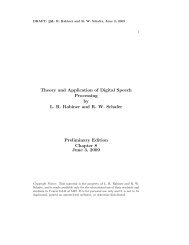Theory and Application of Digital Speech Processing by L. R. ...
Theory and Application of Digital Speech Processing by L. R. ...
Theory and Application of Digital Speech Processing by L. R. ...
You also want an ePaper? Increase the reach of your titles
YUMPU automatically turns print PDFs into web optimized ePapers that Google loves.
DRAFT: L. R. Rabiner <strong>and</strong> R. W. Schafer, June 3, 2009<br />
22 CHAPTER 1. INTRODUCTION TO DIGITAL SPEECH PROCESSING<br />
Phonemes: /dId yu it yεt/<br />
Articulator Dynamics: /dI j@ it jεt/<br />
Although the perfectly articulated sentence, as seen <strong>by</strong> the sequence <strong>of</strong><br />
phonemes shown above, is completely underst<strong>and</strong>able, the reality <strong>of</strong> human<br />
speech production is that the sounds co-articulate (blend into each other, especially<br />
at word boundaries) as much as possible, leading to the set <strong>of</strong> actual sounds<br />
shown in the line labeled articulator dynamics above, where the phoneme /d/ at<br />
the end <strong>of</strong> ‘did’ <strong>and</strong> the phoneme /y/ at the beginning <strong>of</strong> ’you’ co-articulate to<br />
produce the /j/ sound, <strong>and</strong> the vowel /u/ <strong>of</strong> ’you’ becomes the highly reduced<br />
vowel /@/; furthermore the beginning sound <strong>of</strong> ‘yet’ becomes a /j/ sound rather<br />
than the fully articulated /y/ sound, as expected from the text. The amazing<br />
aspect <strong>of</strong> human speech perception is that almost every native speaker <strong>of</strong> English<br />
will underst<strong>and</strong> the highly co-articulated sequence shown above, irrelevant<br />
<strong>of</strong> the degree <strong>of</strong> co-articulation in producing the speech signal. All <strong>of</strong> these linguistic<br />
variations in sounds make speech processing for speech underst<strong>and</strong>ing a<br />
rather difficult process, as we will see in Chapter 14.<br />
1.8 <strong>Speech</strong> Science<br />
Although the primary emphasis in this book is on signal processing analyses<br />
<strong>of</strong> speech signals, a complete underst<strong>and</strong>ing <strong>of</strong> speech requires forays into the<br />
following areas <strong>and</strong> sub-areas <strong>of</strong> speech science:<br />
Linguistics: the science <strong>of</strong> language<br />
Phonetics: the study <strong>of</strong> speech sounds, their production, transmission,<br />
<strong>and</strong> reception, <strong>and</strong> their analysis, classification <strong>and</strong> transcription<br />
Phonemes: the smallest set <strong>of</strong> units considered to be the basic set <strong>of</strong><br />
distinctive sounds <strong>of</strong> a language (there are between 20 <strong>and</strong> 60 phoneme<br />
units for most languages)<br />
Phonemics: the study <strong>of</strong> phonemes <strong>and</strong> phonemic systems<br />
Syntax: analysis <strong>and</strong> description <strong>of</strong> the grammatical structure <strong>of</strong> a body<br />
<strong>of</strong> textual material<br />
Semantics: analysis <strong>and</strong> description <strong>of</strong> the meaning <strong>of</strong> a body <strong>of</strong> textual<br />
material <strong>and</strong> its relationship to a task description <strong>of</strong> the language<br />
We will have numerous occasions, throughout this book, to examine each<br />
<strong>of</strong> these areas <strong>of</strong> <strong>Speech</strong> Science to see how they affect algorithms for speech<br />
processing for various applications. Further, in Chapter 3, we will extensively<br />
look at the acoustic-phonetic properties <strong>of</strong> speech as a basis for underst<strong>and</strong>ing<br />
how speech is created <strong>and</strong> how various speech sounds are represented in the<br />
time <strong>and</strong> spectral domains.

















